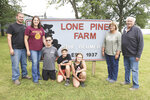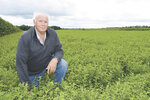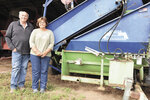


Describe your farm and facilities. We have a lot of family members that help on the farm. Our daughter, Leann, and her husband, Chad, help a lot. They do a milking a day and help with hay and silage harvest. Their children, Blake, Luke and Brooke, are here all the time during the summer and on the weekends during the school year. Our son, Allen, and his wife, Heather, help with fieldwork as well. Our granddaughter, Avery, milks weekday mornings during the summer. Reed and Veda help when available. The grandkids all like being on the farm. We milk in a double-5 herringbone parlor. Cows are housed in a sand-bedded freestall barn with an open lot. We have drive-by feeding.
What forages do you harvest? We harvest Northrup King corn silage, Croplan alfalfa haylage and grass haylage for the dairy cows and heifers.
How many acres of crops do you raise? We grow 200 acres of corn, 100 acres of alfalfa and 70 acres of grass.
Describe the rations for your livestock. All animals are fed a total mixed ration. All the dairy cows get the same ration. They get alfalfa haylage, corn silage and a grain mix. Dry cows get corn silage and grass haylage with a dry cow protein in their ration. Heifers get corn silage, some alfalfa and a grass haylage along with heifer protein.
What quality and quantity do you harvest of each crop? For corn silage, we like to chop between 65%-70% moisture and this usually yields 1,600 tons. We like to chop alfalfa at 60%-65%. Our goal for alfalfa haylage is above 170 relative forage quality. Most of the time it is between 180-200 RFQ. We have had as high as 265. We put up about 1,200 tons.
Describe your harvesting techniques for alfalfa and corn silage. All our forage is stored in ag bags. We bought our first bagger 40 years ago and have been very happy with the feed quality. Corn silage is chopped with a pull-type chopper with a kernel processor. Alfalfa is harvested every 30 days starting the last week of May. It is put in wind rows when cut and chopped when ready. We never turn the hay or double the wind rows so that we don’t lose any leaves. This also to limits compaction on the field as much as possible to prolong the life of the stand. Our stands usually last 4-5 years.
What techniques do you use to store, manage and feed your forages? We store the feed in bags. That way we can use each bag individually for whichever animals it works best for based on quality. We have one field of grass hay that we don’t apply any manure to. That way phosphorus levels stay low. This haylage is kept separate for the dry cows.
How do quality forages play in the production goals for your herd? Having top-quality forages allows us to feed less grain and expensive proteins. Every forage is tested, and our nutritionist provides us with a ration. If we are feeding a very high-quality alfalfa, we will then add some high-quality grass haylage to the TMR. Any time I change a forage I get a new ration.
What management or harvesting techniques have changed that have made a notable difference in forage quality? As stated earlier, buying our first bagger 40 years ago really helped us harvest and store top-quality feed. We have also been using roundup-ready alfalfa since it became available. This has really helped provide high-quality haylage. Before we had a bagger, we made small square bales.
Describe a challenge you overcame in reaching your forage quality goals. Bagging our forages and tiling fields has probably been the most beneficial to harvesting forages that allow our cows to milk well and stay healthy.
Comments
No comments on this item Please log in to comment by clicking here